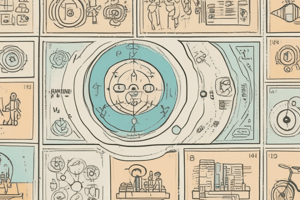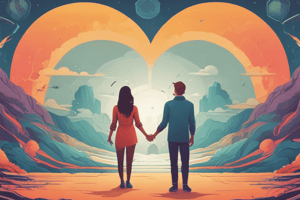Podcast
Questions and Answers
What benefit does awareness of unconscious biases provide in professional interactions?
What benefit does awareness of unconscious biases provide in professional interactions?
- It enhances the capability to manipulate outcomes.
- It allows for competitive advantage in decision-making.
- It reduces the impact of biases on relationships and decision-making. (correct)
- It fosters exclusive interactions tailored to specific individuals.
Which of the following best describes the Courage Mindset?
Which of the following best describes the Courage Mindset?
- Encourages risk aversion and avoiding accountability.
- Fosters a culture of responsibility, accountability, and integrity. (correct)
- Focuses solely on achieving immediate business gains.
- Promotes strict adherence to established rules.
What is a key aspect of the Intention Mindset?
What is a key aspect of the Intention Mindset?
- Establishing clear relationship-focused objectives for projects. (correct)
- Ignoring potential risks in decision-making processes.
- Prioritizing immediate gains over relationship building.
- Setting vague personal goals to avoid failure.
What does the Reciprocity Mindset highlight in a business context?
What does the Reciprocity Mindset highlight in a business context?
How does the Awareness of Impact contribute to responsible behavior in brands?
How does the Awareness of Impact contribute to responsible behavior in brands?
What does UX design primarily focus on?
What does UX design primarily focus on?
Which of the following is NOT a principle of relationship design?
Which of the following is NOT a principle of relationship design?
What does the term 'viability' refer to in human-centered design?
What does the term 'viability' refer to in human-centered design?
Which mindset emphasizes understanding and nurturing relationships in relationship design?
Which mindset emphasizes understanding and nurturing relationships in relationship design?
What is the first stage in the conversation design process?
What is the first stage in the conversation design process?
Desirability in human-centered design refers to what?
Desirability in human-centered design refers to what?
Which of the following options best describes service design?
Which of the following options best describes service design?
What does the Compassion Mindset primarily emphasize in workplace interactions?
What does the Compassion Mindset primarily emphasize in workplace interactions?
Which aspect is NOT associated with the Courage Mindset?
Which aspect is NOT associated with the Courage Mindset?
How does the Intention Mindset influence relationship dynamics?
How does the Intention Mindset influence relationship dynamics?
What is a crucial component of the Reciprocity Mindset?
What is a crucial component of the Reciprocity Mindset?
What does recognizing humanity in the Compassion Mindset involve?
What does recognizing humanity in the Compassion Mindset involve?
Which mindset encourages individuals to address unconscious biases?
Which mindset encourages individuals to address unconscious biases?
What is an incorrect view of the Compassion Mindset?
What is an incorrect view of the Compassion Mindset?
What is the primary outcome of implementing the Compassion Mindset in product design?
What is the primary outcome of implementing the Compassion Mindset in product design?
What role does vulnerability play in the Courage Mindset?
What role does vulnerability play in the Courage Mindset?
Which mindset focuses on the mutual exchange of value?
Which mindset focuses on the mutual exchange of value?
What is the primary goal of Human-Centered Design (HCD)?
What is the primary goal of Human-Centered Design (HCD)?
Which criterion of Human-Centered Design ensures solutions meet real needs and hold value for users?
Which criterion of Human-Centered Design ensures solutions meet real needs and hold value for users?
What does the Reciprocity Mindset focus on in relationships?
What does the Reciprocity Mindset focus on in relationships?
What is NOT a consideration of Human-Centered Design?
What is NOT a consideration of Human-Centered Design?
Which aspect is NOT part of UX design goals?
Which aspect is NOT part of UX design goals?
What does the Courage Mindset encourage individuals to embrace?
What does the Courage Mindset encourage individuals to embrace?
Which of the following is an important aspect of feasibility in Human-Centered Design?
Which of the following is an important aspect of feasibility in Human-Centered Design?
Which of the following describes the term 'viability' in Human-Centered Design?
Which of the following describes the term 'viability' in Human-Centered Design?
What does UX design aim to enhance for users?
What does UX design aim to enhance for users?
What is the main principle underlying service design?
What is the main principle underlying service design?
Which goal of service design focuses on brand experience consistency?
Which goal of service design focuses on brand experience consistency?
How does relationship design differ from service design?
How does relationship design differ from service design?
What is a key objective of relationship design?
What is a key objective of relationship design?
Which of the following best describes sustainability in relationship design?
Which of the following best describes sustainability in relationship design?
Which aspect does inclusivity in relationship design focus on?
Which aspect does inclusivity in relationship design focus on?
What is NOT a consideration in relationship design?
What is NOT a consideration in relationship design?
What does relationship design aim to facilitate?
What does relationship design aim to facilitate?
Which of the following best encapsulates the essence of social values in relationship design?
Which of the following best encapsulates the essence of social values in relationship design?
Which of the following statements about relationship design is accurate?
Which of the following statements about relationship design is accurate?
Flashcards
UX Design
UX Design
Focuses on the user's feelings and experiences with a product or service. It considers usability, accessibility, and overall satisfaction.
Service Design
Service Design
Encompasses the entire customer journey, from the initial contact to the final interaction. It aims to create a seamless and satisfying experience across all touchpoints.
Relationship Design
Relationship Design
Building strong and meaningful connections with customers, employees, and communities. It focuses on creating lasting relationships based on trust, empathy, and shared values.
Viability
Viability
Signup and view all the flashcards
Desirability
Desirability
Signup and view all the flashcards
Feasibility
Feasibility
Signup and view all the flashcards
Compassion Mindset
Compassion Mindset
Signup and view all the flashcards
Courage Mindset
Courage Mindset
Signup and view all the flashcards
Reciprocity Mindset
Reciprocity Mindset
Signup and view all the flashcards
Human-Centered Design (HCD)
Human-Centered Design (HCD)
Signup and view all the flashcards
Main Idea Behind HCD
Main Idea Behind HCD
Signup and view all the flashcards
Comprehending User Goals
Comprehending User Goals
Signup and view all the flashcards
Criteria of HCD
Criteria of HCD
Signup and view all the flashcards
UX Design: Enhances User Interaction
UX Design: Enhances User Interaction
Signup and view all the flashcards
Goals of UX Design
Goals of UX Design
Signup and view all the flashcards
UX Design: Positive User Experiences
UX Design: Positive User Experiences
Signup and view all the flashcards
Transparency and Accountability
Transparency and Accountability
Signup and view all the flashcards
Intention Mindset
Intention Mindset
Signup and view all the flashcards
Risk Management
Risk Management
Signup and view all the flashcards
Co-Creation
Co-Creation
Signup and view all the flashcards
Community-Centric Design
Community-Centric Design
Signup and view all the flashcards
External Partnerships
External Partnerships
Signup and view all the flashcards
Recognizing Humanity
Recognizing Humanity
Signup and view all the flashcards
Diverse Voices
Diverse Voices
Signup and view all the flashcards
Compassion in Design
Compassion in Design
Signup and view all the flashcards
Collaborative Compassion
Collaborative Compassion
Signup and view all the flashcards
What is service design?
What is service design?
Signup and view all the flashcards
How does relationship design differ from service design?
How does relationship design differ from service design?
Signup and view all the flashcards
What is the goal of engagement in relationship design?
What is the goal of engagement in relationship design?
Signup and view all the flashcards
Explain the importance of 'connection' in relationship design.
Explain the importance of 'connection' in relationship design.
Signup and view all the flashcards
What are the social values considered in relationship design?
What are the social values considered in relationship design?
Signup and view all the flashcards
What is inclusivity in relationship design?
What is inclusivity in relationship design?
Signup and view all the flashcards
Explain sustainability within relationship design.
Explain sustainability within relationship design.
Signup and view all the flashcards
What are ethical considerations in relationship design?
What are ethical considerations in relationship design?
Signup and view all the flashcards
How does relationship design expand on UX design?
How does relationship design expand on UX design?
Signup and view all the flashcards
What is the core focus of relationship design?
What is the core focus of relationship design?
Signup and view all the flashcards
Study Notes
Human-Centered Design
- Human-centered design (HCD) aims to create solutions that address user needs and preferences.
- Key characteristics:
- Desirability: The solution meets real needs and is desirable.
- Feasibility: The solution is constructible and implementable.
- Viability: The solution is economically sustainable.
Mindsets of Relationship Design
- Compassion: Understanding, empathy, and nurturing relationships.
- Intention: Clear goals and intentions in interactions.
- Courage: Embracing vulnerability, taking risks, and facing discomfort.
- Reciprocity: Exchange of value, fostering long-lasting connections.
Relationship Design Principles
- Engagement: Building connections.
- Connection: Fostering relationships.
- Social values: Considering societal and environmental implications.
- Sustainability: Solutions are environmentally friendly.
- Inclusivity: Solutions are accessible and welcoming to diverse groups.
- Ethics: Solutions do not harm any individual, avoiding biases and promoting fairness.
User Experience (UX) Design
- Goal: Enhance user interactions with a product for positive experiences.
- Focus: Aesthetics, behavior, technology, and environment.
- Metrics: User-friendliness, task completion speed, and user satisfaction.
Service Design
- Focus: All interactions with a company, going beyond specific products.
- Goal: Create a consistent and enjoyable customer journey across all interactions.
Conversation Design
- Goal: Reduce interaction friction and build trust between brands and customers.
- Stages:
- Discover: Identifying user needs and context.
- Ideate: Brainstorming and defining conversational strategies.
- Prototype: Creating and testing conversational flows.
- Revise: Refining based on user feedback.
Ethics by Design
- Focus: Integrating ethical considerations into product design and development.
- Key principles:
- Understanding the impact of products.
- Embedding ethics in product design.
- Partnerships with organizations (stakeholder engagement)
Consequence Scanning
- Goal: Proactively address potential negative consequences of products and features, and identify opportunities for positive impact.
- Methods:
- Identifying and avoiding potential negative impacts.
- Managing risks in product development.
- Documenting responsibilities for addressing issues.
The document explores how to incorporate Human-Centered Design (HCD) into customer solutions. Key highlights include:
-
Core Design Types:
- UX Design: Enhancing individual product interactions.
- Service Design: Focusing on the end-to-end customer journey.
- Relationship Design: Building deeper connections across users, employees, and communities.
-
HCD Criteria:
- Desirability: Solutions must address genuine user needs.
- Feasibility: Ensure practical and resource-aligned implementation.
- Viability: Align solutions with sustainable business models.
-
Relationship Design Mindsets:
- Compassion: Empathy and understanding in design.
- Intention: Clear and purposeful interactions.
- Courage: Embracing challenges and vulnerability.
- Reciprocity: Balancing giving and receiving value.
-
Ethics and Sustainability:
- Emphasizing inclusivity, reducing harm, and ensuring long-term environmental and social responsibility.
-
Conversation Design:
- Structured in four stages: discover, ideate, prototype, and revise.
- Emphasizes effective communication and customer trust-building.
-
Best Practices:
- Address biases, prioritize user feedback, and focus on proactive ethical strategies like consequence scanning.
Studying That Suits You
Use AI to generate personalized quizzes and flashcards to suit your learning preferences.




